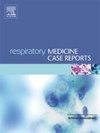肺间质性疾病伴疑似曲霉菌瘤的侵袭性曲霉菌病伴肺动脉假性动脉瘤并发大咯血1例
IF 0.7
Q4 RESPIRATORY SYSTEM
引用次数: 0
摘要
背景:侵袭性肺曲霉病(IPA)是一种严重的并发症,特别是存在结构性肺疾病如间质性肺疾病(ILD)的患者。血管侵入性IPA可导致肺动脉假性动脉瘤(PAP),这是一种罕见但危及生命的大咯血源。我们报告一例78岁的美国白人男性,患有ILD(可能来自橙剂暴露)和慢性低氧性呼吸衰竭,依赖家庭氧气,表现为复发性大咯血。ct血管造影(CTA)显示右上肺叶腔1.5 cm的PAP。尽管没有典型的致病性免疫抑制,支气管肺泡灌洗(BAL)培养和半乳甘露聚糖检测支持肺曲霉病的诊断。虽然怀疑是侵袭性疾病,但由于缺乏先前的影像学检查,不能排除曲菌瘤具有半侵袭性成分的可能性。紧急线圈栓塞以控制出血,随后用伏立康唑进行抗真菌治疗。结论本病例强调ILD患者应早期怀疑肺曲霉病,应用BAL和CTA进行诊断,并联合血管内栓塞和抗真菌药物治疗。由于缺乏既往影像学和潜在的纤维化肺疾病,区分侵袭性疾病与半侵袭性或慢性形式可能具有挑战性。本文章由计算机程序翻译,如有差异,请以英文原文为准。
Massive hemoptysis due to pulmonary artery pseudoaneurysm in invasive aspergillosis in a patient with interstitial lung disease and suspected Aspergillioma: A case report
Background
Invasive pulmonary aspergillosis (IPA) is a serious complication, particularly in patients with existing structural lung disease like interstitial lung disease (ILD). Angioinvasive IPA can lead to pulmonary artery pseudoaneurysm (PAP), which is a rare but life-threatening source of massive hemoptysis.
Case presentation
We present the case of a 78-year-old white American male with ILD (potentially from Agent Orange exposure) and chronic hypoxic respiratory failure, dependent on home oxygen, who presented with recurrent, massive hemoptysis. Computed Tomography Angiography (CTA) showed a 1.5 cm PAP in the right upper lobe cavity. Despite no classical causative immunosuppression, a diagnosis of pulmonary aspergillosis was supported by bronchoalveolar lavage (BAL) culture and galactomannan testing. Although invasive disease was suspected, the possibility of an aspergilloma with a semi-invasive component could not be excluded due to lack of prior imaging. Urgent coil embolization was performed to control the hemorrhage, followed by antifungal treatment with voriconazole.
Conclusion
This case underscores the need for early suspicion of pulmonary aspergillosis in ILD patients, utilizing BAL and CTA for diagnosis, and combining endovascular embolization with antifungals. Given the absence of prior imaging and underlying fibrotic lung disease, distinguishing invasive disease from semi-invasive or chronic forms can be challenging.
求助全文
通过发布文献求助,成功后即可免费获取论文全文。
去求助
来源期刊

Respiratory Medicine Case Reports
RESPIRATORY SYSTEM-
CiteScore
2.10
自引率
0.00%
发文量
213
审稿时长
87 days
 求助内容:
求助内容: 应助结果提醒方式:
应助结果提醒方式:


